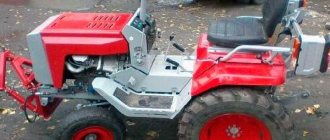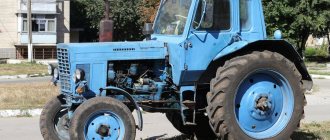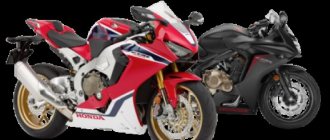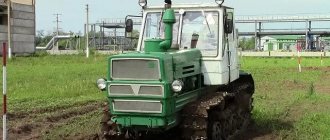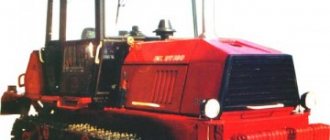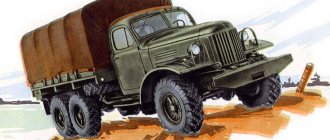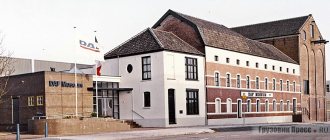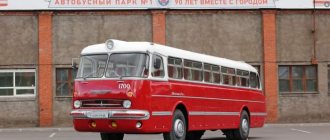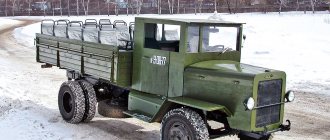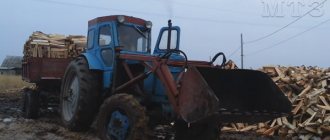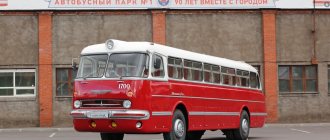Author: Ivan Rzhanov
06 November 2022 21:47
Tags: USSR Tractors agriculture
10334
5
1
The first Soviet five-year plans were a stunning success. One of the main elements was agriculture. At the same time, Soviet production was developing at a tremendous pace in the USSR, in particular, modern tractors were created and produced, which were so necessary for developing agriculture. But what were they?
Wheeled tractor "Universal 2"
0
See all photos in the gallery
Universal tractors were produced from 1934 to 1940 at the Leningradsky and from 1944 to 1955 at the Vladimir Tractor Plant. The cars of the first series, Universal-1 and Universal-2, differed in the design of the front axle. The U-1 had front wheels offset to the center; on the U-2 they were spaced apart on the front axle beam. Accordingly, the tractor had additional steering rods. The tractor was equipped with a 4-cylinder kerosene engine with a power of 22 hp. and a transmission with three forward gears and one reverse gear. The operating speed range of the U-2 tractor was from 3.9 to 8.1 km/h with an operating weight of 2108 kg. It was the Universal-2 that became the first Soviet tractor to be exported. The total number of station wagons produced is 211,500.
"Kolomenets-1"
The principle of creating a single tractor farm, which was laid down by Lenin, could be realized thanks not only to the production of “iron horses”, but also to the adoption of a set of measures that contributed to the organization of a testing and research base, as well as solving issues of organization and repair, opening various courses on training of masters and instructors.
The first tractors of the USSR were produced in 1922 at the Kolomensky plant. The leader of this project was E. D. Lvov. He is considered the founder of the Russian school of tractor building.
The first unit was named “Kolomenets-1”. Without any doubt, he was a real symbol of the beginning of a new era in the country's agriculture.
Wheel tractor SHTZ-15/30
0
The most popular Soviet wheeled tractor of the first half of the 20th century, 390,500 copies were produced. It was produced at the Stalingrad Tractor Plant (from 1930) and the Kharkov Tractor Plant (from 1931) until 1937, and in the post-war period (1948-1950) at the Moscow Automobile Repair Plant. The design is based on one of the best wheeled tractors of that time, McCormick-Deering 15/30 from the American company International Harvester. The kerosene 4-cylinder engine developed a power of 31.5 hp. and allowed operation in a speed range from 3.4 to 7.4 km/h. Operating weight of the tractor is 3000 kg.
Firstborn of Russia
Our country has always been rich in talent. It was also famous for its inventors. Among them were those who worked in the field of creating equipment for agriculture.
The issue of mechanization of agriculture was raised back in the 18th century. agronomist I.M. Komov. By the middle of the 19th century. D. A. Zagoyaksky and V. P. Guryev developed steam tractors intended for plowing. The first such tracked unit was assembled and tested in 1888 by F.A. Blinov.
However, the official date of the emergence of the Russian tractor industry is considered to be 1896. It was then that at the fair in Nizhny Novgorod the world's very first steam tractor on caterpillar tracks was demonstrated to the assembled public.
By the beginning of the 20th century. designer Ya. V. Mamin invented a non-compression engine that ran on heavy fuel. It was great for vehicle operation. The first tractor, which was equipped with an 18-kilowatt internal combustion engine, was assembled in 1911. This unit was called very patriotically - “Russian”. After modernization, this tractor received a 33 kW engine. This gave him more power. Small-scale production of such tractors was mastered at the Balaklava plant. This equipment was produced individually in Kolomna and Bryansk, Kharkov and Rostov, Kichkass and Barvenkov, as well as in some other settlements. However, the total number of tractors produced in Russia was so small that it could not have a significant impact on the state of affairs in agriculture. By 1913, there were 165 tractors in the country. However, at the same time, the Russian Empire actively imported agricultural machinery. By 1917, 1,500 pieces were brought into the country.
Crawler tractor STZ-3 (SHTZ-NATI)
0
After the cessation of production of the SKHTZ-15/30 wheeled tractor in 1937, the Stalingrad and Kharkov Tractor Plants switched to the production of the STZ-3 tracked tractor. This was the first mass-produced tractor, the design of which was entirely developed by Soviet engineers. The tractor had a riveted frame, a chassis of four carriages with a balanced suspension with coil springs, and a semi-closed cab. The 4-cylinder water-cooled kerosene engine developed a power of 52 hp. on the shaft and 46 hp. on the drive pulley. The weight of the tractor was 3800 kg. After the evacuation of the Kharkov plant to the city of Rubtsovsk, STZ-3 was also produced at the Altai Tractor Plant (from 1942 to 1952). In Stalingrad and Kharkov, production of the STZ-3 was curtailed a little earlier, in 1949, when it gave way to the DT-54 tractor on the assembly line. The total number of cars produced is 191,000.
Prototypes of modern tractors
The first tractor model, equipped with tracks instead of wheels, was produced more than 2 centuries ago. To drive it, a steam engine was used. This machine was designed by the English engineer John Gitcot to drain swamps. But this technical invention had a number of significant drawbacks. It was bulky and noisy. Therefore, it turned out to be not in demand.
During this time period, or more precisely in 1837, the Russian engineer Dmitry Zagryazhsky, who served as a staff captain on a military cruiser, requested a patent for the invention. In the past, a hereditary peasant, Zagryazhsky invented and described in detail the design of a carriage on tracks, equipped with a steam engine. However, his invention remained unclaimed.
Another crawler tractor, an analogue of the Gitcot device, was built in the American state of California approximately twenty years after the creation of the first models. It was 1857. The tractor was intended for farm agricultural work. Its creator, designer Miller, was awarded a special prize for the “originality of the invention.” But this model of tractor was not in demand.
The prototype of a modern tractor was designed and implemented in 1888 by a simple peasant from the Saratov province. It was Blinov F.A. His car moved on two tracks. They, through a special gear mechanism (propeller), were driven by an engine powered by two steam boilers. Each tracked pair was controlled separately. This was done by two people. The tractor developed a speed of slightly more than 3 km/h (three miles). That is, the tractor moved at the speed of a cart pulled by oxen. By 1897, Blinov improved his creation. But the tractor, due to complex controls and imperfect engine operation, also turned out to be unclaimed.
Around the same time period (1897), in Germany, Rudolf Diesel designed and patented the first internal combustion engine running on gasoline. It differed markedly from the steam engine in its economical fuel consumption and greater power generated. A little later (1903), the internal combustion engine was designed in Russia. The authorship of the invention belongs to Y.V. Mamin. and unlike the German engine, Mamin’s engine ran on fuel made from petroleum products.
In 1911, Mamin demonstrated a tractor equipped with tracks and an internal combustion engine of his own design. But Russia was still an agricultural country that did not have its own machine-building factories. Therefore, Mamin’s tractor also remained just a prototype.
Crawler tractor S-65 Stalinets
0
The first Soviet diesel tractor was produced at the Chelyabinsk Tractor Plant from 1937 to 1941. It was a further development of the S-60 design with a carburetor engine. The M-17 diesel engine developed a power of 65 hp. and allowed the tractor with a total weight of 10850 kg to reach a maximum speed of 6.95 km/h. Late production vehicles were equipped with a closed cabin. With the outbreak of the Great Patriotic War, most of the S-65s were withdrawn for the needs of the army and were used as artillery tractors. In the German army, captured S-65s were also used to tow heavy guns. Presented at the Oldtimer Gallery, the S-65 got stuck in one of the swamps in the Pskov region during the retreat of the Red Army, where it lay at a depth of 7 meters to this day. In 2008, the tractor was removed from the swamp captivity and immediately went to Shamansky’s workshop for restoration.
Construction of new production facilities
Over time, it became obvious that in order to provide collective farms with the necessary agricultural equipment, it was necessary to build special factories. In them, production facilities should be combined with research and design bureaus. The initiator of such a project was F. E. Dzerzhinsky. It was planned to equip the new enterprises with the most advanced equipment. This would make it possible to establish mass production of reliable and cheap models on tracked and wheeled traction.
The history of USSR tractors as objects of large-scale production began in Stalingrad. After this, the capacities of the Leningrad and Kharkov plants were significantly expanded. The largest enterprises appeared in Chelyabinsk, Barnaul, Minsk and other cities of the country.
On June 17, 1930, the first domestic mass-produced tractor, the wheeled agricultural STZ-1 or STZ-15/30, rolled off the assembly line of the Stalingrad (STZ), now Volgograd (VgTZ), tractor plant. This day is also considered the birthday of STZ/VgTZ, the first specialized tractor plant in the USSR. The production of tractors in our country began in 1922, when a specially organized state commission for tractor construction developed a plan for the production of tractors for 1924-1926. The need to manufacture tractors was dictated primarily by the huge loss in agriculture during the years of the First World War and the Civil War of draft animals: horses, oxen (in 1936, their deficit was projected at 12.4 million heads), the loss of the already small number of imported Russia of tractors, and also, probably, the upcoming collectivization of agriculture. The first attempts to organize the production of tractors at general engineering enterprises in Kolomna, Zaporozhye, Marx, Kharkov, even in Leningrad at the Putilov (today St. Petersburg Kirov) plant were not crowned with success: tractors were assembled in insufficient quantities, were of different brands and expensive: their price was 2-2.5 times higher than the price of foreign cars of equal power. In 1925, a decision was made to build specialized tractor factories in our country, the first of which was founded in Stalingrad the following year. The choice of tractor type was made based on a study of the design, test results and operating experience, incl. in the USSR, 28 different models of tractors: 23 wheeled and 5 tracked. Then, for further more detailed study, the following were selected from them: the American “International 10/20”, the unified with it “International 15/30”, “Oil-Pull” (“Oil-Pul”), the German “Hanomag” VD 10/20 and "Advance" 15/30 of a Swedish oil engine manufacturer of the same name. The first three cars ran on kerosene, the Advance ran on crude oil. It was also considered and already produced at the mentioned Putilovsky.| American tractor "International 15/30" - a prototype of the future STZ-1 | American tractor "Oil Pull" - one of the contenders for the Stalingrad conveyor |
| To the right of the first experimental STZ-1 tractor being assembled in the mechanical repair shop, another contender is visible - the Swedish Avance tractor. | German tractor "Hanomag" of the 20s. last century. Perhaps this is VD 10/20, also a contender for the STZ conveyor |
As a result of the work carried out, preference was given to International tractors. Among the advantages of the “Internationals” over their competitors were, in particular, the following: - rational layout; — ease of management and maintenance; - relative low cost of the machine (Table 1) and low cost of its repair; — successful selection of transmission gear ratios; — the ability to work in the field with all existing types of implements, incl. with a three-furrow plow; ease of use on a stationary basis to drive machines from a lateral power take-off pulley with a transverse axis of rotation; — adaptability of the design to large-scale production.
Table 1 Comparison of cost indicators of various wheeled tractors - prototypes for the first tractor plant of the USSR
Note: * The indicated hook power differs from the values declared by the manufacturer.
The site for the construction of the first tractor plant was chosen based on an analysis of the following conditions: - supply of the plant with raw materials, materials, fuel, energy; — shipment of finished products; — cost of construction materials and work; — labor market, housing conditions. The cities of Voronezh, Zaporozhye, Rostov-on-Don, Stalingrad, Kharkov and Chelyabinsk were discussed. Based on the set of listed criteria, the choice settled on Stalingrad. For example, the total cost of transporting raw materials and finished products for Stalingrad, according to calculations, turned out to be 12% and 24% lower, respectively, than for Rostov or Voronezh; the average transportation distance of manufactured tractors to consumption centers is 4% and 22% less than for Voronezh or Zaporozhye (Table 2). To be fair, it should be said that the name of Stalingrad probably played a role in choosing the location for the first tractor plant in the USSR, and tractor factories were also subsequently built in Kharkov and Chelyabinsk.
Table 2 Comparison of transport costs and transportation distances for the considered points of construction of the first tractor plant of the USSR
Initially, it was planned to produce at the future STZ a cheaper tractor of the International 10/20 type with a power of 15 kW (20 hp) in the amount of 10 thousand per year. In the summer of 1928, a decision was made to increase the annual productivity of Seversky Plant to 20 thousand machines, and in December, after an in-depth analysis of the needs of the country's agriculture - to 40 thousand and reorientation of the plant to produce a similar design, but more powerful tractor International 15/30 . During these years, Soviet engineers, in addition to the design (together with the American firm of architect Albert Kahn) and the construction of a huge plant, solved two more complex problems: the production of parts was transferred to domestic materials and the American design documentation for the tractor was converted from inches to metric, adopted in the USSR. system. Illustrating the complexity of the task, it is enough to mention that, for example, the engine of the American prototype had a cylinder diameter of 114.3 mm (4.5 inches), a piston stroke of 152.4 mm (6 inches), and the Stalingrad tractor had 115 and 152, respectively. mm. Such seemingly small alterations entailed the need for large recalculations, resizing and reworking of all tractor drawings. The first Soviet mass-produced tractor was branded STZ-1, or STZ-15/30 (in the literature there are also references to it under the brand name simply STZ and the name “International Construction of STZ”).
| June 17, 1930 The first serial STZ-1 rolls off the main assembly line of the Stalingrad Tractor Plant | The first production tractor STZ-1 in the Museum of Modern History of Russia (former Museum of the Revolution), Moscow |
Wheel agricultural the STZ-1 tractor (medium power according to the then classification) had a successful and progressive design for its time with simple, easy-to-use components adapted for mass production, which distinguished it favorably from other tractors of that period, incl. from the fairly common Fordson Putilovsky - FP (49.5 thousand of these cars were produced in the USSR in 1924-1932). STZ-1 was divided into 96 groups (for comparison: in the modern VT-150D tractor there are 35 of them excluding diesel and some other purchased units), 6 sets and 2 mechanisms, which made it possible to divide the assembly into many separate simple ones, accessible for quickly mastering operations and reduce the rate at which tractors are removed from the assembly line. The skeleton of the STZ-1 tractor was formed by a transmission housing and a cast semi-frame attached to it in front, on which a 4-stroke in-line 4-cylinder overhead valve carburetor engine, a radiator and a front axle were attached. The engine had a rigid cast crankcase, wet liners of vertically located cylinders, a 2-bearing crankshaft parallel to the longitudinal axis of the tractor, mounted on ball bearings, cast iron pistons with 3 compression rings and 1 oil scraper ring each, forged connecting rods with bronze bushings in the upper head and filled Babbitt liners in the bottom, upper valves in the block head. The gear pump of the lubrication system supplied oil to 4 trays, from where it was captured and sprayed by the protrusions (spoons) of the lower connecting rod heads, lubricating the rubbing surfaces. Engine cooling is thermosiphon water with a tubular radiator and a 4-blade fan driven from the toe of the crankshaft by a flat belt. The main fuel - cheap kerosene, starting fuel - gasoline was supplied to the Ensign RW type carburetor by gravity; To prevent detonation, water was also supplied to the cylinders by the carburetor. Air purification was carried out with a Pomona type oil air purifier. The fuel mixture in the intake manifold was heated by the exhaust gases of the exhaust manifold passing nearby. Spark ignition of the working mixture was carried out from a high-voltage magneto of the Scintilla type. The engine was started manually using a handle. The specified engine operating mode was maintained by a centrifugal regulator.
| Longitudinal section of the STZ-1 tractor | STZ-1 tractor engine |
The clutch is a friction single-disc, non-permanently closed. The gearbox with longitudinal shafts and movable spur gears provided 3 forward gears and 1 reverse gear. The main gear is bevel; differential - bevel 4-satellite; the final drives were located in the same compartment of the transmission housing with the main gear and differential; Torque from the engine to the drive wheels was transmitted through only 2 pairs of cylindrical and 1 pair of bevel gears, which ensured minimal losses in the transmission. All transmission shafts were mounted on rolling bearings with cylindrical helical rollers, axial loads were carried by thrust ball bearings, and the axle shafts of the drive wheels were carried by tapered roller bearings. The brake is an open band type, the pulley of which was installed externally on the shaft of the driven bevel gear of the main gear. The brake was controlled by a hand lever. The rear driving metal wheels, protected by wings, were equipped with 2 rows of wedge-shaped spurs; front steerable ones of smaller diameter, mounted on a swing axle, with annular flanges. The steering mechanism is a worm-type with a rear-facing steering linkage (better known at that time as the Jeantot mechanism). Single-wire electrical equipment with a nominal voltage of 6V consisted of a generator, front and rear headlights and a plug box for 3 additional consumers (light bulbs). The working equipment included a rear hitch with a tow hook and a power take-off pulley located on the right (625 min-1). If necessary, the tractor was easily equipped with a rear dependent power take-off shaft. From the list of design solutions included in the tractor chosen for production in Stalingrad, it is clear that many of them have become traditional for wheeled tractors of the classical layout. The technical characteristics of the STZ-1 tractor in comparison with the FP tractor produced at the same time (and for comparison with the modern domestic LTZ-55A and McCormick S80MAX of the same weight) are given in table. 3.
Table 3. Technical characteristics of wheeled tractors FP, STZ-1 and modern LTZ-55A, McKormick S80MAX
Notes: 1 - according to the classification of the 1930s; 2 – according to the modern type; 3 – now the Kirov plant, St. Petersburg; 4 – in 1931-1937. the tractor was also produced by KhTZ, and in 1948-1952. – was assembled by the Second Moscow Automobile Repair Plant; 5 – in Russia, the tractor is produced in Naberezhnye Chelny under the brand name SMAX85; 6 – for the radiator; along the air intake pipe - 2450 mm; 7 – in the cabin; 8 – front wheel track 1460-1790 mm; 9 – under the front axle; 10 – agrotechnical clearance; 11 – with creeper -16; 12 – with traction efficiency 0.62; 13 – rear wheel tires 13.6R38; front wheel tires 8.3-20; 14 – rear wheel tires 480/70R34 (according to other sources – 16.9R34); front wheel tires 380/70R24 (according to other sources 12.4R24); 15 - with extensions - 470 mm; 16 – symbols: trailer hitch – rear tow hitch; PWM – power take-off pulley; RNU – rear linkage; power take-off shaft: VOMz – dependent, VOMn – independent, VOMs – synchronous.
Mastering the production of STZ-1 was not easy. This was due to insufficient equipment, interruptions in the supply of materials and purchased products, and most importantly, a lack of qualifications and experience among workers, engineers and managers. In 1930 Only 1006 machines were assembled, in 1931 - 17536. Only in April 1932 did Seversky Plant master the design capacity of 144 tractors per day, and soon exceeded it.
| STZ-1 tractors ready for shipment on the factory grounds along the western wall of the engine shop. The rear wheel hooks and the front wheel flanges were already installed at the consumer’s site. | Loading the STZ-1 tractor onto a railway platform | 4 STZ-1 tractors were loaded onto a two-axle railway platform at the plant. |
| STZ-1 on moldboard plowing. To improve engine cooling, the sides of the hood were often raised or removed | Two STZ-1 for sowing and compacting crops | STZ-1 harvesting flax. Power take-off pulley removed |
| Harvesting of cereal grains. 2 STZ-1 tractors tow a trailed combine harvester "Stalinets-6" | STZ-1 in a unit with a trailed combine harvester "Kommunar". During the Great Patriotic War, cleaning had to be carried out in the most incredible conditions | Transport tractor-tractor on pneumatic tires based on KhTZ-1. The photo was taken during the Great Patriotic War at a naval aviation airfield |
The Kharkov Tractor Plant also mastered the production of the same tractor under the HTZ-1 brand in October 1931, and with less difficulty. After this, the “unified brand” of the tractor, SHTZ-1, began to be used. Every year, STZ and KhTZ began to provide the country with 40 thousand of these much-needed machines. In total, almost 397 thousand SHTZ-1 tractors were manufactured, more than half of them - 207 thousand - in Stalingrad. In 1948-1952. the STZ-1 type tractor was also produced by enterprises in Moscow and the Moscow region; their assembly from components and parts manufactured mainly by defense enterprises was carried out at the Second Moscow Automobile Repair Plant. These tractors were also known under the VARZ brand. The STZ-1 tractor turned out to be very successful: powerful enough for that time, unpretentious, easy to operate and repair, reliable and enjoyed well-deserved recognition from machine operators. On collective and state farms, the tractor was used for almost all types of work: basic and surface tillage, sowing, harvesting grain, fodder and industrial crops, driving stationary machines and transport. SHTZ-1 in 1930-1940 was the most common tractor and was in use until the mid-1950s. And the author of these lines, even in 1971, in the magazine “Kukuruza”, saw a photograph of a line of tractors from one of the farms prepared for spring field work, and on the right flank of the line there was still a veteran of SHTZ-1. The production of SHTZ-1 lasted a relatively short time: 7 years (1930-1937), during which time its design remained virtually unchanged. But it is known that KhTZ based on agricultural The tractor was produced by a transport tractor-tractor on pneumatic tires, developed jointly with the Scientific Research Tractor Institute (NATI). Work was also carried out to equip the SHTZ-1 tractor with a half-track. One of the active participants in this work was the All-Union Scientific Research Institute of Agricultural Mechanization (VIM); The military showed significant interest in the half-track. After the Great Patriotic War, research work was also carried out to create an electric tractor based on the SHTZ-1. One of the samples, under the brand name ETK-500, was developed jointly with the already mentioned VIM and the All-Union Scientific Research Institute for Electrification of Agriculture (VIESKh), the second, under the brand name MET-1, was developed by defense research institutes. A pilot batch of MET-1 tractors consisting of 30 machines was manufactured.
| STZ-1 on an American half-track | Electric tractor based on STZ-1 |
In July 1937, the wheeled STZ-1 was replaced by a new agricultural machine, more powerful and productive, more suitable for the soil, climatic and road conditions of our country. tractor - caterpillar STZ-NATI, completely domestic design. In September of the same year, in Kharkov, the same tracked SKhTZ-NATI replaced the wheeled KhTZ-1. Volgograd tractor manufacturers have the right to be proud that they were the first.
| The McCormick company continues to produce wheeled agricultural products. tractors even today. The picture shows the model C80MAX | The most powerful tractor model today is Mac Cormick TTX-230 (T3), 225 hp. With. | The most powerful of the VgTZ tractors is the experimental T-5 Donchak, 230 hp. With. |
The STZ-1 tractor (first on the right) in the exhibition of manufactured tractors on the VgTZ in-plant square near the monument to tractor builders of all generations. 2010
Aultman Taylor 30-60
Aultman Taylor began producing tractors in 1911. Their main creation was the Model 30-60, which became the most popular steam tractor in the world. Initially, the tractor was equipped with a cubic boiler like the Hart-Parr 30, then it was replaced with the usual tubular one. But the most famous was the unit with a “cut” pipe similar to a sieve.
Reconstruction of production
In 1936, STZ did not reduce the production of the wheeled model and at the same time carried out the reconstruction that was required for the production of a new tractor. First of all, new workshops were put into operation: modeling and pressing, with an area of 20 thousand square meters. m, and a steel foundry, with 16 electric furnaces and 9 molding conveyors, with an area of 55 thousand square meters. m (one of the largest in the USSR). It contained 2.5 km of conveyors and transporters.
The mechanical assembly and tool shops, as well as the repair base, were significantly expanded. In addition, a motor-tractor laboratory was created. American and German equipment used to produce the wheeled model was supplemented by Soviet-made machines. Machine tools have almost doubled. Accordingly, new technologies have been developed for the manufacture of many components and parts.
To complete the reconstruction, the plant was stopped for only two months. The new tractor rolled off the large assembly line at 10:25 p.m. on July 11, 1937.
Transport version STZ-5
In parallel with the agricultural version, SHTZ-NATI, designers were developing a transport one. It received the designation STZ-NATI-2TV, but later was better known as STZ-5. STZ engineers I.I. did a lot for its development. Drong and V.A. Kargopolov and NATI specialists A.V. Vasiliev and I.I. Trepenenkov. STZ-5 was extremely unified with SHTZ-NATI, and both models were produced on the same assembly line.
This tractor had a traditional layout for transport tractors. A two-seater (for the driver and gun commander) closed wood-metal cabin was located in front, above the engine. Behind it and the fuel tanks was a wooden cargo platform with folding sides and a removable canvas top. The platform had four folding semi-soft seats for the gun crew and space for ammunition and artillery equipment.
The frame consisted of two longitudinal channels connected by four different cross members. The 1MA engine, four-cylinder, carburetor, with magneto ignition, was actually multi-fuel - this was especially important for army tractors. It was started on gasoline using an electric starter or a crank handle, and after warming up to 90 ° C, it was switched to kerosene or naphtha.
To prevent detonation and increase power, especially when working with increased loads in the summer, on kerosene, water was injected into the cylinders through a special carburetor system, and since 1941, an anti-knock combustion chamber was introduced.
The gear ratios in the gearbox were changed to increase the power range and driving speeds, and another (lower) gear was introduced. When moving on it at a speed of 1.9 km/h, the STZ-5 developed a thrust of 4850 kgf, that is, at the limit of adhesion of the tracks to the ground.
The chassis was more adapted to movement at high speeds: the caterpillar pitch was halved, the support and support rollers were rubberized. To pull trailers, pull out the tractor and tow other vehicles, a vertical capstan with a 40 m long cable was installed on the rear axle housing under the platform. The cabin had opening front and side windows, as well as adjustable blinds in the front and rear parts.
Post-war history
Despite the difficulties of wartime, tractor builders did not forget about their favorite work. The thought arose: why not use the experience of the Americans? After all, in the USA during the war years, the production of tractors did not stop. The analysis showed that the best of the American tractor models is the D-7. In 1944, the development of documentation and design began.
Two years later, simultaneously with the reconstruction of the plant, on January 5, 1946, the first S-80 tractor was produced. By 1948, the restructuring of the enterprise was completed; 20-25 units of tracked vehicles were produced per day. In 1955, the design bureaus began work on creating a new, more powerful S-100 tractor and continued work to increase the durability of the S-80 tractor.
Models:
- S-60 (tracked, 1933).
- S-65 (tracked, 1937).
- S-80 (tracked, 1946).
- S-100 (tracked, 1956).
- DET-250 (tracked, 1957).
- T-100M (tracked, 1963).
- T-130 (tracked, 1969).
- T-800 (tracked, 1983).
- T-170 (tracked, 1988).
- DET-250M2 (tracked, 1989);
- T-10 (tracked, 1990).
T-150
Tractors produced in the USSR were distinguished by their reliability. The high-speed universal units T-150 and T-150K had the same characteristics. They have earned a good reputation due to their wide range of applications. In addition to agriculture, they were used in road construction and transport. And you can still find these models working in the fields, in difficult off-road conditions and transporting goods.
The T-150 and T-150K have a 6-cylinder turbocharged diesel engine with a V-shaped configuration and liquid cooling. The power of such a motor reaches 150 hp. With. Maximum speed – 31 km/h.
Tractor plant in Chelyabinsk
This enterprise has made a significant contribution to equipping agriculture with the necessary equipment. And during the war, the production of “self-propelled guns” and tanks was established here.
Construction of ChTZ began in an open field, located away from the main highways. When designing the plant, the first production facilities of which were launched in 1930, the experience of similar enterprises in the USA was taken into account.
On June 1, 1933, the first tracked tractor “Stalinets-60” rolled off the ChTZ assembly line. In 1936, more than 61 thousand of them were produced. Today, these tractors are considered obsolete. But in the 30s, in terms of their characteristics, they were almost twice as superior to the equipment produced by STZ and KhTZ.
Beginning in 1937, ChTZ began producing more economical S-65 models. A year later, this tractor received the highest award - the “Grand Prix” at an exhibition in Paris. You can also see the S-65 in the movies. It was used during the filming of the famous film “Tractor Drivers”.
In 1946, the plant underwent a radical reconstruction. Simultaneously with the modernization of equipment, production of the S-80 began. In 1948, after the final restructuring of the enterprise, ChTZ produced from 20 to 25 units of equipment per day. In 1955, the plant's design bureau began work on creating a more powerful tractor, the S-100 model. At the same time, the development of new options that would increase the durability of the S-80 did not stop.
Models of tractors produced by ChTZ during the USSR period are represented by the following tracked ones:
- S-60 (1933);
- S-65 (1937);
- S-80 (1946);
- S-100 (1956);
- DET-250 (1957);
- T-100M (1963);
- T-130 (1969);
- T-800 (1983);
- T-170 (1988);
- DET 250M2 (19789);
- T-10 (1990).
Adopting foreign experience
While the tractors of the USSR were “building up their muscles”, and Soviet designers were mastering a new direction for themselves, the government decided to launch production of foreign equipment under license. In 1923, the Kharkov plant put into production the tracked Kommunar, which was the successor to the German model Hanomag Z-50. They were primarily used by the military to transport artillery pieces until 1945 (and later).
In 1924, the Leningrad (future Kirov) mastered the production of a cheap and structurally simple “American”. Old USSR tractors of this brand have proven themselves quite well. They were head and shoulders superior in performance to both the Zaporozhets and Kolomenets. The carburetor kerosene engine (14.7 kW) developed a speed of up to 10.8 km/h, and the power at the hook was 6.6 kW. The gearbox is three-speed. The model was produced until 1932. In fact, this was the first large-scale production of this technology.
